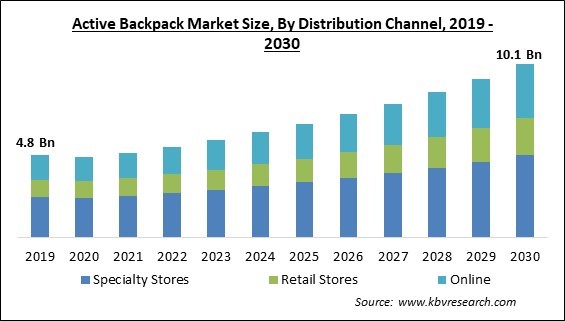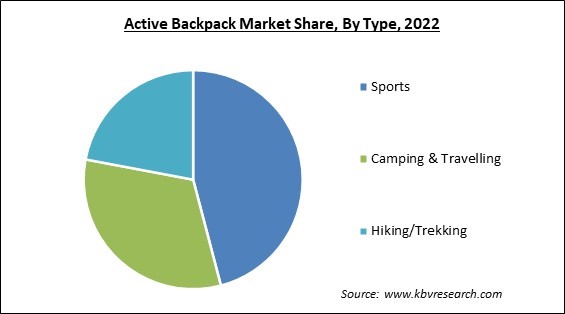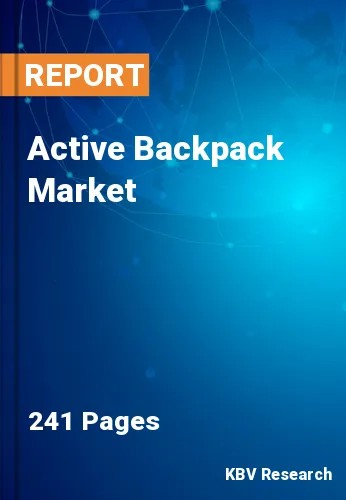The Global Active Backpack Market size is expected to reach $10.1 billion by 2030, rising at a market growth of 8.5% CAGR during the forecast period.
20L-40L size backpacks are widely utilized by individuals because of the increasing prevalence of mobile lifestyles. The rapid spread of urbanization is responsible for increased travel for jobs, education, and leisure activities. Consequently, the 20L-40L size segment is expected to capture approximately 1/2nd share of the market by 2029. The increase in disposable income of urban residents and the development of infrastructure have contributed to the growth of mobile lifestyle. Individuals need to carry some stuff in bags daily due to their reliance on technology and the requirement to travel for work or education.
The trend toward designing products with the consumer in mind is growing amongst manufacturers, for instance, companies are now offering smart backpacks with advanced technologies. As technological demand from consumers increases, different companies, including Board Sports, Adidas, and newcomers like Eume, are offering product portfolios in response to consumer needs. Some of the factors impacting the market are rising technological development in product designs, the growing popularity of camping and other recreational activities, and the rising prevalence of counterfeit goods.

The demands from people of all ages are evolving due to the quickly shifting trends and technological advancements globally. Bags and luggage of the twenty-first century are created with consideration to the needs of the consumer requirements. The rise of work-from-home job models has accelerated the staycation trend among working professionals. As a result, the market has continued to rise as more people need to carry accessories, electronics, and documents. The increased need for an authentic and customized tourism experience, which is being driven by quick modernization, the influence of social media, and affordable airline tickets, is one of the key factors driving market expansion. Furthermore, travel companies are introducing user-friendly, and speedy mobile websites that are easy to access on smartphones. As a result, the demand for products like active backpacks is witnessing significant growth.
However, cheaper materials are used to create counterfeit goods sold under the names of well-known market participants, illegally. Exclusive brand counterfeiting is more common in poorer nations where people are more cost-conscious. This factor inhibits the economic sale of original brand-name products. Counterfeit items' poor quality often causes inconvenience, safety concerns, and negative customer perception. Due to this, as well as the increasing availability and sales of counterfeit goods, the market may witness a significant decline in growth.
Based on type, the market is categorized into hiking/trekking, camping & travelling, and sports. In 2022, the sports segment held the highest revenue share in the market. Over the past several years, there has been a significant growth in the number of individuals participating in sports as more people pursue an active lifestyle. This trend has been fuelled by several factors, such as growing awareness about the health advantages of regular exercise, increased disposable incomes, and the availability of more diversified and approachable sports and fitness options.

Based on size, the market is bifurcated into less than 10L, 10L-20L and 20L-40L. In 2022, the 20-40 L segment witnessed the largest revenue share in the market. Most hikers use active backpacks with a 20 to 40-liter capacity, as they are required to carry many goods including hiking equipment. These packs are highly durable and adaptable, allowing them to withstand rigorous hiking or athletic activities.
Based on price point, the market is classified into $51 - $100, $101 - $150, $151 - $200, under $50, and above $201. The under $50 segment acquired a substantial revenue share in the market in 2022. There is an increasing need for inexpensive backpacks that can withstand the rigors of outdoor use as more individuals participate in outdoor activities like traveling and working out. Active backpacks under $50 are well-positioned to address this need by offering a reasonably priced solution for customers who are just beginning to explore outdoor activities.
By distribution channels, the market is divided into specialty stores, retail stores and online. In 2022, the online segment registered the maximum revenue share in the market. Because of the ease of use, convenience, increased variety, and financial advantages of e-commerce websites, consumers prefer shopping from these sites. Additionally, e-commerce websites offer convenience to customers by delivering their purchases right to their door. Also, many retailers provide discounts year-round, making pricey items like active backpacks somewhat accessible. Such promotions draw a significant customer base and present opportunities for higher sales of active backpacks through this sales channel.
| Report Attribute | Details |
|---|---|
| Market size value in 2022 | USD 5.3 Billion |
| Market size forecast in 2030 | USD 10.1 Billion |
| Base Year | 2022 |
| Historical Period | 2019 to 2021 |
| Forecast Period | 2023 to 2030 |
| Revenue Growth Rate | CAGR of 8.5% from 2023 to 2030 |
| Number of Pages | 241 |
| Number of Table | 459 |
| Report coverage | Market Trends, Revenue Estimation and Forecast, Segmentation Analysis, Regional and Country Breakdown, Companies Strategic Developments, Company Profiling |
| Segments covered | Type, Price Point, Size, Distribution Channel, Region |
| Country scope | US, Canada, Mexico, Germany, UK, France, Russia, Spain, Italy, China, Japan, India, South Korea, Singapore, Malaysia, Brazil, Argentina, UAE, Saudi Arabia, South Africa, Nigeria |
| Growth Drivers |
|
| Restraints |
|
Region-wise, the market is analyzed across North America, Europe, Asia-Pacific and LAMEA. In 2022, the North America region led the market by generating the highest revenue share. The key driver of the market is the availability of several adventure sports locations in the US and Canada. The increase in sports enthusiasts in North America has led to increased backpack usage, which will help the market's growth. Additionally, it is projected that the region's well-established sports industry and improved product visibility will drive up demand throughout the forecast period.
Free Valuable Insights: Global Active Backpack Market size to reach USD 10.1 Billion by 2030
The market research report covers the analysis of key stake holders of the market. Key companies profiled in the report include Samsonite International S.A., JanSport (VF Corporation), Osprey Packs, Inc. (Helen of Troy Limited), Vista Outdoor, Inc. (CamelBak Products LLC), Columbia Sportswear Company, ANTA Sports Products Limited, Deuter Sport GmbH (Schwan-Stabilo Group), Exxel Outdoors, LLC, and Patagonia, Inc.
By Type
By Price Point
By Size
By Distribution Channel
By Geography
The Market size is projected to reach USD 10.1 billion by 2030.
The growing popularity of camping and other recreational activities are driving the Market in coming years, however, The rising prevalence of counterfeit goods will hamper market expansion restraints the growth of the Market.
Samsonite International S.A., JanSport (VF Corporation), Osprey Packs, Inc. (Helen of Troy Limited), Vista Outdoor, Inc. (CamelBak Products LLC), Columbia Sportswear Company, ANTA Sports Products Limited, Deuter Sport GmbH (Schwan-Stabilo Group), Exxel Outdoors, LLC, and Patagonia, Inc.
The $51 - $100 segment acquired the maximum revenue share in the Market by Price Point in 2022, thereby achieving a market value of $2.8 billion by 2030.
The Less than 10L segment has shown the high growth rate of 9.3% during (2023 - 2030).
The North America market dominated the Market by Region in 2022 and would continue to be a dominant market till 2030; thereby, achieving a market value of $3.8 billion by 2030.
Our team of dedicated experts can provide you with attractive expansion opportunities for your business.

